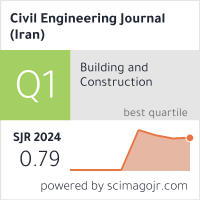Effect of Silica Powder on the Bond between Building Stones and Pumice Concrete
Downloads
The Concrete Backed Stone (CBS) masonry structures are common in many countries in the Middle East. The weak bond and heavyweight are two main problems facing such masonry structures. In this research, Pumice Lightweight Aggregate Concrete (PLWAC) containing silica powder addition is used in backing building stones. The main objective of this research is to investigate the effect of using silica powder addition on the bond strength between building stones and the PLWAC. An experimental program is conducted to investigate the bond strength by applying a direct shear load to the concrete-stone interface. The study investigated the effect of some parameters such as the silica content, the stone surface roughness, and the concrete strength on the bond between lightweight concrete and building stones. The stone roughness comprised specimens of saw-cut and grooved stones with different groove depths. Tests showed that the bond and the compressive strength of the PLWAC increased by increasing the silica content up to 15 percent, where they start to decline. The increase in bond strength corresponding to 10 and 15 percent silica content was 14 and 33 percent, respectively. Increasing the stone roughness by about 50 percent of the saw-cut surface area provided a full bond between the building stones and their backing concrete. Furthermore, the study offered a formula that estimates the bond strength and agrees well with test results.
Doi:10.28991/cej-2021-03091656
Full Text:PDF
Downloads
[2] ASTM C330M-17, "Standard Specifications for Aggregate Lightweight for Structural Concrete,” (2017).
[3] Basha, Ali, and Magdy Salama. "Finite Element Analysis of Tie Beams Under the Effect of Differential Settlement of Isolated Footings.” Civil Engineering Journal 3, no. 9 (October 7, 2017): 650–660. doi:10.21859/cej-03092.
[4] M. I. M. Rjoub, and M. T. Awwad, "Effect of Silica Powder Addition to some Properties of Concrete” Journal of Engineering Sciences (JES) 33, no. 5 (September 2005): 1715-1721.
[5] Meyyappan, PL, R Sutharsan, and M AhamedAzik Ali. "Experimental Investigation on the Effect of Silica Fume and Pumice Stone in Developing Light Weight Concrete.” IOP Conference Series: Materials Science and Engineering 561 (November 12, 2019): 012064. doi:10.1088/1757-899x/561/1/012064.
[6] Chaudhary, Satish Kumar, and Ajay Kumar Sinha. "Effect of Silica Fume on Permeability and Microstructure of High Strength Concrete.” Civil Engineering Journal 6, no. 9 (September 1, 2020): 1697–1703. doi:10.28991/cej-2020-03091575.
[7] V. Srivastava, R. Kumar, V. C. Agarwal, and P. K. Mehta, "Effect of Silica Fume on Workability and Compressive Strength of OPC Concrete.” Journal of Environmental Nanotechnology 3, no. 3 (September 2014): 32–35. doi:10.13074/jent.2014.09.143086.
[8] Imam, Ashhad, Vikash Kumar, and Vikas Srivastava. "Review study towards effect of Silica Fume on the fresh and hardened properties of concrete." Advances in concrete construction 6, no. 2 (2018): 145-157, doi:10.12989/acc.2018.6.2.145.
[9] Kranthi Vijaya, Sathi, Kalla Jagadeeswari, and Karri Srinivas. "Behaviour of M60 Grade Concrete by Partial Replacement of Cement with Fly Ash, Rice Husk Ash and Silica Fume.” Materials Today: Proceedings (August 2020). doi:10.1016/j.matpr.2020.07.523.
[10] Kumar, Ram, and Jitender Dhaka. "Review paper on partial replacement of cement with silica fume and its effects on concrete properties." International Journal for Technological Research in Engineering 4, no. 1 (2016): 65-76.
[11] El-Feky, Muhammad S., Mohamed I. Serag, Ahmed M. Yasien, and Hala Elkady. "Bond strength of nano silica concrete subjected to corrosive environments." ARPN Journal of Engineering and Applied Sciences 11, no. 23 (2016): 13909-13924.
[12] Shin, H. C., and Z. Wan. "Interfacial shear bond strength between old and new concrete." Fracture Mechanics of Concrete and Concrete Structures Assessment, Durability, Monitoring and Retrofitting of Concrete Structures, Korea Concrete Institute, Seoul (2010): 1195-1200.
[13] M. I. M. Rjoub, "Bond Between Concrete and Building Stones in Stone Masonry Structures.” The Masonry Society Journal 23, no. 1 (2005): 121-129.
[14] Bingöl, A. Ferhat, and Rüstem Gül. "Residual Bond Strength between Steel Bars and Concrete after Elevated Temperatures.” Fire Safety Journal 44, no. 6 (August 2009): 854–859. doi:10.1016/j.firesaf.2009.04.001.
[15] ASTM C97-18 American Society for Testing and Material, "Standard test for Absorption and Bulk Specific Gravity of dimension stone.” (2018).
[16] ASTM C170 American Society for Testing and Material, "Standard test Method for Compressive strength of dimension stone,” (1999).
[17] ACI 318-19, Building Code requirements for Structural concrete and Commentary, Farmington Hill, MI, (June 2019): 357.
[18] Helmick, Cristy Guenther, Saadet Toker-Beeson, and Jennifer Eisenhauer Tanner. "Evaluation of shear and diagonal tension in plain concrete." Concrete International 38, no. 1 (2016): 39-46.
- Authors retain all copyrights. It is noticeable that authors will not be forced to sign any copyright transfer agreements.
- This work (including HTML and PDF Files) is licensed under a Creative Commons Attribution 4.0 International License.![]()















